
An echinoderm is any member of the phylum Echinodermata of marine animals. The adults are recognizable by their radial symmetry, and include starfish, sea urchins, sand dollars, and sea cucumbers, as well as the sea lilies or "stone lilies". Adult echinoderms are found on the sea bed at every ocean depth, from the intertidal zone to the abyssal zone. The phylum contains about 7000 living species, making it the second-largest grouping of deuterostomes, after the chordates. Echinoderms are the largest phylum that has no freshwater or terrestrial members.

Crinoids are marine animals that make up the class Crinoidea, one of the classes of the phylum Echinodermata, which also includes the starfish, brittle stars, sea urchins and sea cucumbers. Those crinoids which, in their adult form, are attached to the sea bottom by a stalk are commonly called sea lilies, while the unstalked forms are called feather stars or comatulids, being members of the largest crinoid order, Comatulida.

Starfish or sea stars are star-shaped echinoderms belonging to the class Asteroidea. Common usage frequently finds these names being also applied to ophiuroids, which are correctly referred to as brittle stars or basket stars. Starfish are also known as Asteroids due to being in the class Asteroidea. About 1,900 species of starfish occur on the seabed in all the world's oceans, from the tropics to frigid polar waters. They are found from the intertidal zone down to abyssal depths, 6,000 m (20,000 ft) below the surface.

The crown-of-thorns starfish, Acanthaster planci, is a large starfish that preys upon hard, or stony, coral polyps (Scleractinia). The crown-of-thorns starfish receives its name from venomous thorn-like spines that cover its upper surface, resembling the biblical crown of thorns. It is one of the largest starfish in the world.

Brittle stars, serpent stars, or ophiuroids are echinoderms in the class Ophiuroidea closely related to starfish. They crawl across the sea floor using their flexible arms for locomotion. The ophiuroids generally have five long, slender, whip-like arms which may reach up to 60 cm (24 in) in length on the largest specimens. From New Latin ophiurus, from Ancient Greek ὄφις + οὐρά.

Balanoglossus is an ocean-dwelling(only Marine water dwelling, not fresh water dwelling) acorn worm (Enteropneusta) genus of great zoological interest because, being a Hemichordate, it is an "evolutionary link" between invertebrates and vertebrates. Balanoglossus is a deuterostome, and resembles the Ascidians or sea squirts, in that it possesses branchial openings, or "gill slits". It has notochord in the upper part of the body and has no nerve chord. It does have a stomochord, however, which is gut chord within the collar. Their heads may be as small as per 2.5 mm (1/10 in) or as large as 5 mm (1/5 in).
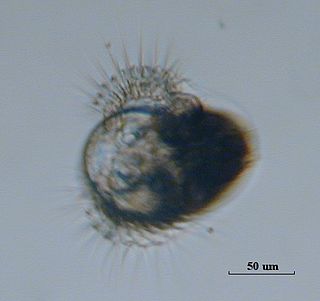
A veliger is the planktonic larva of many kinds of sea snails and freshwater snails, as well as most bivalve molluscs (clams) and tusk shells.
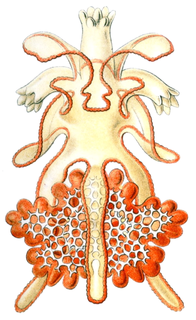
A brachiolaria is the second stage of larval development in many starfishes it follows the bipinnaria. Brachiolaria have bilateral symmetry, unlike the adult starfish, which have a pentaradial symmetry. Starfish of the order Paxillosida have no brachiolaria stage, with the bipinnaria developing directly into an adult.

The acorn worms or Enteropneusta are a hemichordate class of invertebrates consisting of one order of the same name. The closest non-hemichordate relatives of the Enteropneusta are the echinoderms. There are 111 known species of acorn worm in the world, the main species for research being Saccoglossus kowalevskii. Two families—Harrimaniidae and Ptychoderidae—separated at least 370 million years ago.

Dipleurula is a hypothetical larva of the Echinoderms. It represents the type of basis of all larva forms of the Eleutherozoa, to which the sea-stars, sea-hedgehog, sea-rollers and sand stars belong. The Dipleurula is a bilaterally symmetrical, ciliated echinoderm larva.

The Echinasteridae are a family of starfish in the monotypic order Spinulosida. The family includes eight genera and about 133 species found on the seabed in various habitats around the world.

Luidia sarsii is a species of starfish. Sand colored with a velvety texture, the species expresses pentamerism or pentaradial symmetry as adults. The five gently tapering arms have conspicuous bands of long white marginal spines in groups of three. Luidia sarsi grow to approximately 20 cm across and are found in deeper water (20 m+) from Norway to the Mediterranean but in deep colder water in the south. They are usually found on muddy sediment and are most active at night, burying themselves under the sand during the day. Luidia sarsii larva develop from a fertilized egg and are unique in a number of respects. The larva of the species attains an unusual size and a juvenile starfish develops inside the larva. During metamorphosis the juvenile migrates to the outside and detaches from the swimming larval bipinnaria stage. The larva continues to live separately for several months.
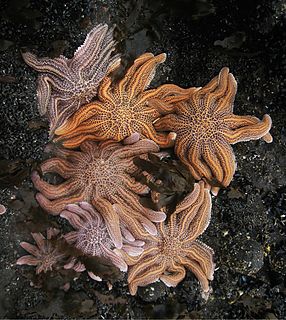
Stichaster australis, the reef starfish, is a species of starfish found in the shallow waters of the rocky intertidal of New Zealand. Typically, the animal is endemic to the west coast shores of the North and South Islands, where wave action is increased. They do not usually inhabit ecosystems that have reduced wave action and calm conditions as they prefer a higher-energy environment. These marine invertebrates range in color from pink to purple, but can also be orange. They typically have eleven arms, but sometimes they may have either ten or twelve. As full-grown adults, they are 8 to 10 cm in diameter.

Acanthaster brevispinus, the short-spined crown-of-thorns starfish, is one of the two members of the starfish genus Acanthaster, along with the much better-known A. planci, the common crown-of-thorns starfish.

Evasterias troschelii is a species of starfish in the family Asteriidae. Its common names include the mottled star, false ochre sea star and Troschel's true star. It is found in Kamchatka and the north western coast of North America.

Astropecten scoparius is a sea star in the family Astropectinidae. It is found in shallow water in the East China Sea and around the coasts of Japan. It is a grey starfish and each of its five arms has a narrow pale margin. It burrows in the muddy sediments on the seabed and feeds on molluscs.
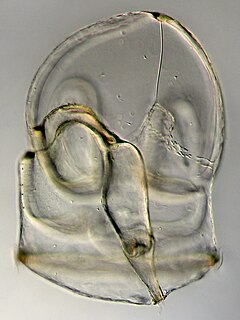
A tornaria is the planktonic larva of some species of Hemichordata such as the acorn worms. It is very similar in appearance to the bipinnaria larvae of starfishes, with convoluted bands of cilia running around the body. It is an oval shaped, transparent larva. The diameter of the body is about 3 mm. It has an apical plate, which is a thickened region provided by a tuft of cilia and a pair of eye spots. The larva has a complete alimentary canal. The ciliary band stretches throughout the anterior and posterior region, and also the postoral region.
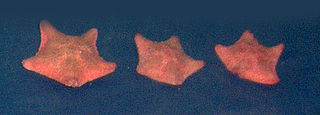
Asterina gibbosa, commonly known as the starlet cushion star, is a species of starfish in the family Asterinidae. It is native to the northeastern Atlantic Ocean and the Mediterranean Sea.
Astropecten latespinosus is a species of starfish in the family Astropectinidae. It is one of the commonest starfish in the seas around Japan. The name in Japanese is hira momiji, "hira" meaning flattened and "momiji" meaning maple leaves tinged with bright red, a name given to certain starfish which resemble maple leaves in form.

Neoferdina cumingi, also known as Cuming's sea star, is a species of starfish in the family Goniasteridae. It is native to the tropical Indo-Pacific region.


















